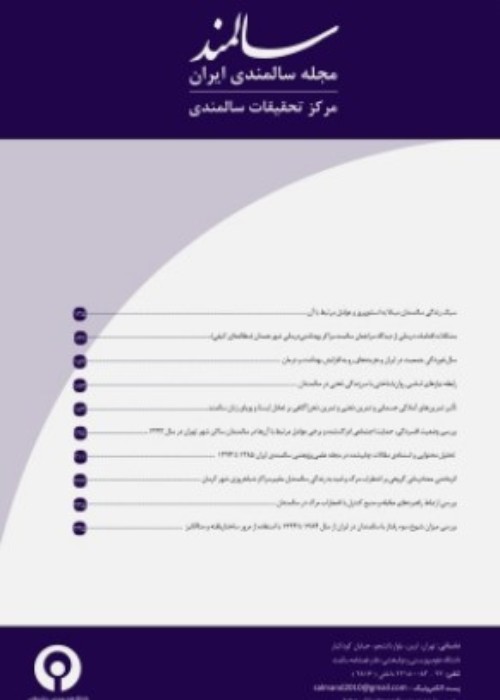Effect of Water-Based Training Frequency on the Balance and Motor Function in Sedentary Elderly Men
Author(s):
Abstract:
Objectives The loss of physiological and functional capacity is a risk factor for falls, disability, and injury or death in the elderly. Water base-exercise (WEX) is one of the proposed methods for improving the performance of the elderly. The aim of this research was to study the effect of water base-exercise frequency on the balance and functional indices of untrained elderly man.
Methods & Materials This was a semi-experimental study consisting of 36 elderly men within the age group of 64.36±2.15 years, height 165.05±4.32 cm, weight 62.89±3.73 kg, and BMI 23.12±1.72, who volunteered to participate in the study. Prior to the initial assessment, each participant gave their written personal consent. Then the subjects were randomly divided into three groups of 12 members each: 2 d·wk-1, 3 d·wk-1, and control group. The water training protocol was followed for six weeks. Functional and balance parameters including flexibility, and strength of the lower extremities were evaluated before and after the completion of the training protocol. The differences in pretest and posttest for each group were examined using the paired t-test and one-way ANOVA was used for comparison among the three groups. The value of P≥0.05 was considered significant. SPSS 17 software was used for carrying out all statistical operations.
Results The search indicated that the factor of static and dynamic balance and movement ability between the 2 d·wk-1 and 3 d·wk-1 WEX groups were not significantly different (P≥0.05). On the other hand, lower extremity strength and flexibility in the 3 d·wk-1 WEX group was significantly different from the 2 d·wk-1 (P≥0.05). Although the t-test results revealed significant differences (P≥0.05) between pretest and posttest scores of the experimental group, this difference was non-significant in the control group (P≥0.05).
Conclusion It was concluded that the balance and movement ability factors of elderly people are highly affected by the volume of practice to training frequency. However, the increase in training frequency could improve other physical factors such as muscle strength and flexibility in the elderly.
Methods & Materials This was a semi-experimental study consisting of 36 elderly men within the age group of 64.36±2.15 years, height 165.05±4.32 cm, weight 62.89±3.73 kg, and BMI 23.12±1.72, who volunteered to participate in the study. Prior to the initial assessment, each participant gave their written personal consent. Then the subjects were randomly divided into three groups of 12 members each: 2 d·wk-1, 3 d·wk-1, and control group. The water training protocol was followed for six weeks. Functional and balance parameters including flexibility, and strength of the lower extremities were evaluated before and after the completion of the training protocol. The differences in pretest and posttest for each group were examined using the paired t-test and one-way ANOVA was used for comparison among the three groups. The value of P≥0.05 was considered significant. SPSS 17 software was used for carrying out all statistical operations.
Results The search indicated that the factor of static and dynamic balance and movement ability between the 2 d·wk-1 and 3 d·wk-1 WEX groups were not significantly different (P≥0.05). On the other hand, lower extremity strength and flexibility in the 3 d·wk-1 WEX group was significantly different from the 2 d·wk-1 (P≥0.05). Although the t-test results revealed significant differences (P≥0.05) between pretest and posttest scores of the experimental group, this difference was non-significant in the control group (P≥0.05).
Conclusion It was concluded that the balance and movement ability factors of elderly people are highly affected by the volume of practice to training frequency. However, the increase in training frequency could improve other physical factors such as muscle strength and flexibility in the elderly.
Keywords:
Language:
Persian
Published:
Iranian Journal of Ageing, Volume:11 Issue: 41, 2016
Page:
330
magiran.com/p1574445
دانلود و مطالعه متن این مقاله با یکی از روشهای زیر امکان پذیر است:
اشتراک شخصی
با عضویت و پرداخت آنلاین حق اشتراک یکساله به مبلغ 1,390,000ريال میتوانید 70 عنوان مطلب دانلود کنید!
اشتراک سازمانی
به کتابخانه دانشگاه یا محل کار خود پیشنهاد کنید تا اشتراک سازمانی این پایگاه را برای دسترسی نامحدود همه کاربران به متن مطالب تهیه نمایند!
توجه!
- حق عضویت دریافتی صرف حمایت از نشریات عضو و نگهداری، تکمیل و توسعه مگیران میشود.
- پرداخت حق اشتراک و دانلود مقالات اجازه بازنشر آن در سایر رسانههای چاپی و دیجیتال را به کاربر نمیدهد.
دسترسی سراسری کاربران دانشگاه پیام نور!
اعضای هیئت علمی و دانشجویان دانشگاه پیام نور در سراسر کشور، در صورت ثبت نام با ایمیل دانشگاهی، تا پایان فروردین ماه 1403 به مقالات سایت دسترسی خواهند داشت!
In order to view content subscription is required
Personal subscription
Subscribe magiran.com for 70 € euros via PayPal and download 70 articles during a year.
Organization subscription
Please contact us to subscribe your university or library for unlimited access!


